
The bald eagle is a well-known American symbol of fortitude, bravery, and independence. For instance, it was chosen to serve as our country’s emblem in 1782 and is currently included on a variety of official U.S. items, such as quarters, passports, and the one-dollar bill.
The bald eagle is a bird found in North America. Their range extends from the Mexican border into the U.S. and Canada. They can be spotted year-round in Alaska, the Rocky Mountains, and along the Mississippi River. The rest of the United States only sees bald eagles during the winter when they are migrating.
The enormous, predatory bald eagle has a hooked yellow beak, brown body, and brown wings. Their heads and tails are white. They have golden feet with piercing black talons. Excellent hunters, these carnivorous animals typically devour fish as well as other birds.
According to studies, bald eagles hunt and eat 400 different species, even some enormous creatures like calf deer! They are opportunistic hunters that eat both dead and alive food.
These birds are quite large! Bald eagles have a stunning 6.5 to 7.5-foot wingspan and can grow to a length of 2.5 to 3.5 feet. Female bald eagles are around 25% larger than males.
For instance, male bald eagles typically weigh 9 pounds, while females tend to weigh around 12 pounds. Bald eagles are unarguably big, but several birds exist that surpass these fearsome predators in size.
Let’s look closely at five huge predators larger than today’s bald eagle!
For a fair comparison, we will be focusing on birds of prey. Let’s go!
Predator Birds: Evolution And Origins
Predator birds, also known as raptors, are a group of birds of prey that have evolved to become highly efficient hunters. These birds are found all over the world and come in a wide variety of shapes and sizes, each with their own unique adaptations for hunting and survival.
The evolution of predator birds can be traced back to the late Jurassic period, over 150 million years ago. During this time, the first birds were evolving from small, feathered dinosaurs, and the ancestors of modern predator birds were beginning to emerge.
One of the earliest known predator birds was Archaeopteryx, a small bird-like dinosaur that lived about 150 million years ago. Archaeopteryx had teeth and claws and was likely a carnivorous predator that hunted small animals and insects.
Over time, predator birds continued to evolve and diversify, with different species developing unique adaptations for hunting and survival.
Some birds, like eagles and hawks, developed sharp talons and powerful beaks for catching and killing prey, while others, like owls, evolved soft, silent feathers for stealthy nighttime hunting.
Steller’s Sea-Eagle
| Steller’s Sea Eagle | Size |
|---|---|
| Maximum Weight: | 20 pounds |
| Maximum Wingspan: | 8 feet |
The Steller’s sea eagle (Haliaeetus pelagicus) is a very sizable nocturnal predatory bird of the Accipitridae family. This majestic bird of prey was named for the German naturalist Georg Wilhelm Steller. This eagle is also referred to as the white-shouldered eagle or the Pacific Sea eagle.
It is the heaviest eagle in the world on average. It can grow to a length of 3.5 feet and has a wingspan of nearly 8 feet, weighing up to 20 pounds.
The Steller’s sea eagle hunts in similar territory to that of the bald eagle. It prefers to live near open water for easy access to fish. Its beak and talons are yellow, while its wings and tail are white with dark brown spots. This magnificent and fearsome hunter, who primarily preys on waterfowl and fish, is found in coastal northeastern Asia.
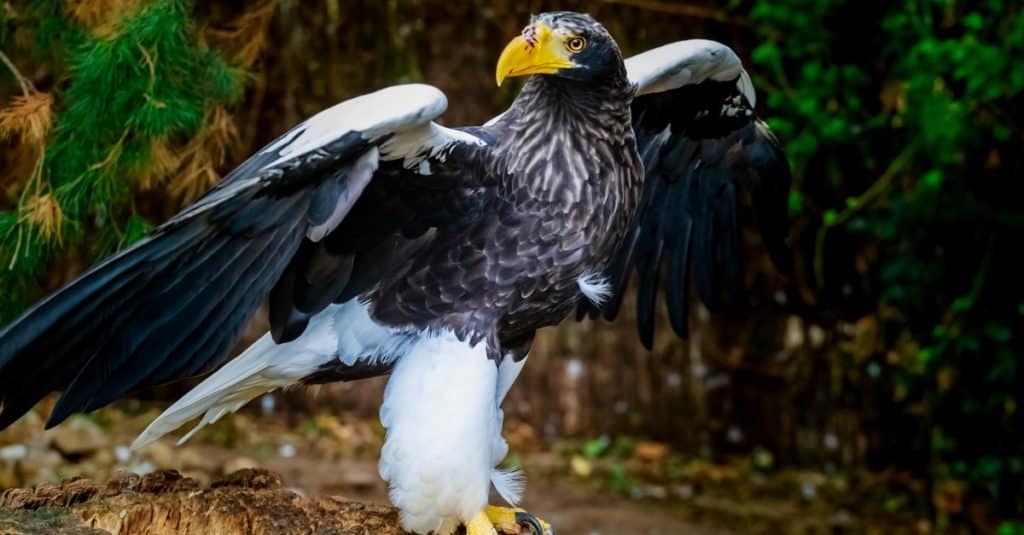
Steller’s sea eagle can grow to a length of 3.5 feet and has a wingspan of nearly 8 feet, weighing up to 20 pounds.
©nnattalli/Shutterstock.com
California Condor
| California Condor | Size |
|---|---|
| Maximum Weight: | 24 pounds |
| Maximum Wingspan: | 9.8 feet |
The California condor, unquestionably the biggest flying bird in North America, can soar on its enormous wings at up to 55 mph by catching wind currents mid-flight.
This bird can weigh up to 24 pounds and has a wingspan of about 10 feet! In the wild, this enormous bird of prey can live for up to 50 years.
California condors like to nest in redwood hollows, rock crevices, or cliff caves. Instead of building a nest, this bird prefers to find pre-existing nesting locations. It also rarely refines its nest using twigs or other materials.
The hardy California condor can endure one to two weeks without food if necessary. Other self-preservation strategies include fluffing their neck feathers to keep warm and peeing down one or both legs to stay cool.
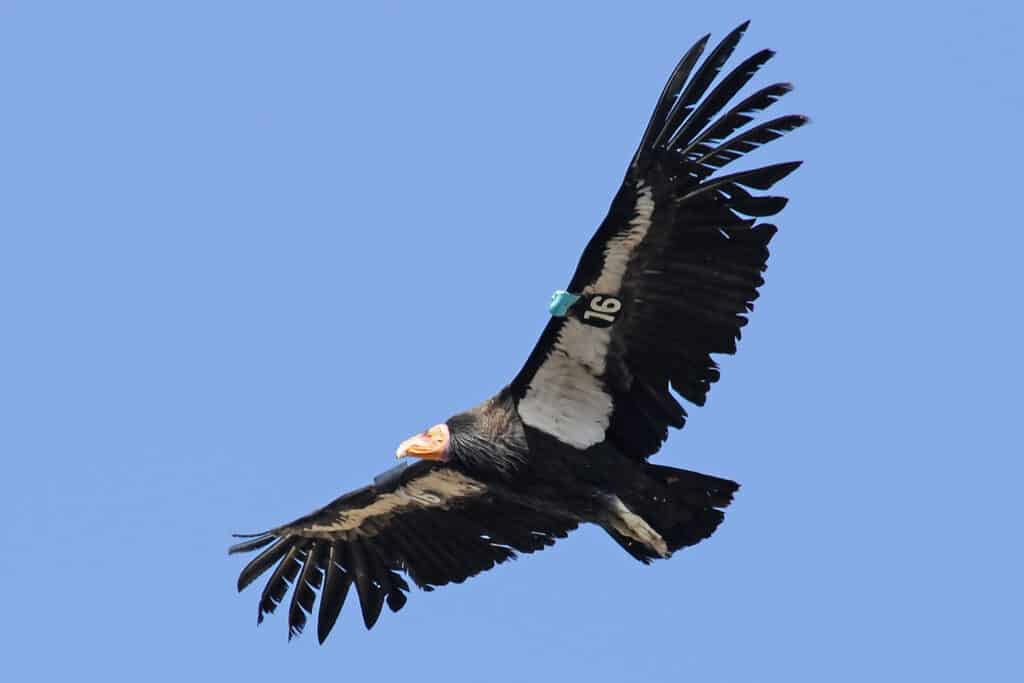
Californian condors can weigh up to 24 pounds and have a wingspan of about 10 feet!
©Brian A Wolf/Shutterstock.com
Himalayan Griffon Vulture
| Himalayan Griffon Vulture | Size |
|---|---|
| Maximum Weight: | 28 pounds |
| Maximum Wingspan: | 9.2 feet |
The Himalayan griffon vulture, likely named for its almost legendary proportions, has a striking appearance, accentuated by a light cowl of soft, downy feathers.
Although head feathers are unusual for carrion birds, they help distinguish the Himalayan griffon. In adult birds, this distinctive crown of feathers is a pale yellow or cream; in young birds, it is a brighter white.
Frequently keeping loose colonies, the Himalayan griffon vulture will also fly in flocks. This bird can weigh up to 28 pounds and has wings that can extend over 9 feet in length! These large birds hatch solitary eggs and build relatively close-knit nests.
Although it rarely attacks people and usually stays to itself, the Himalayan griffon vulture is technically a man-eater. By scavenging the human remains buried on the crags, these enormous birds frequently play a crucial role in Tibetan Sky Burials.
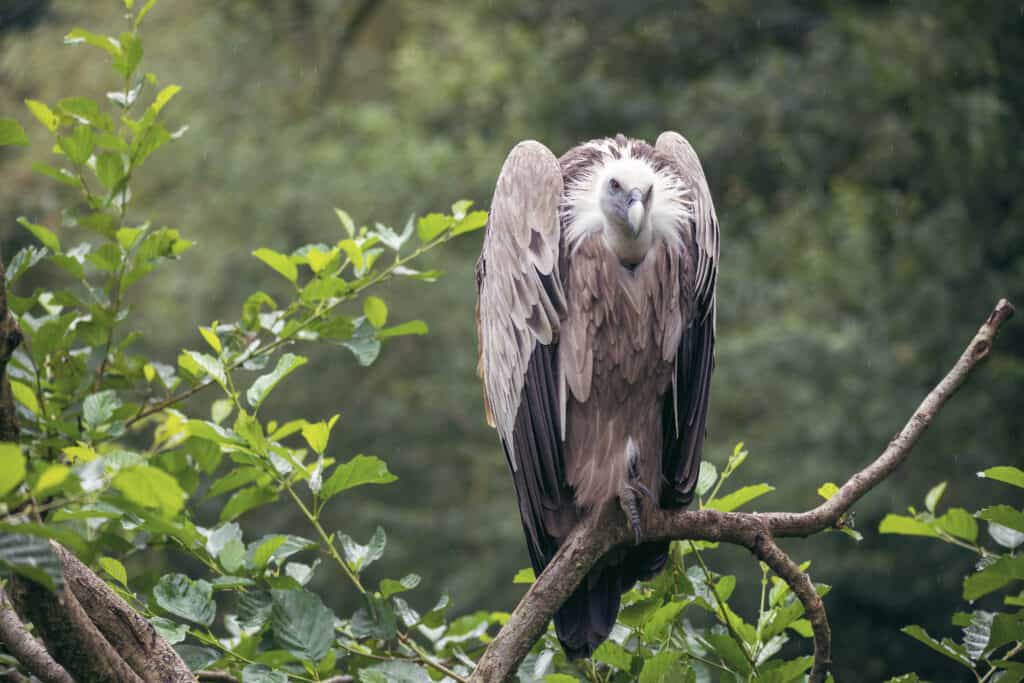
The Himalayan griffin vulture has a striking appearance, accentuated by a light cowl of soft, downy feathers.
©iStock.com/artush
Eurasian Black Vulture
| Eurasian Black Vulture | Size |
|---|---|
| Maximum Weight: | 21 pounds |
| Maximum Wingspan: | 10.2 feet |
The Eurasian black vulture is an enormous member of the Accipitridae family, which also includes buzzards, harriers, and kites. This bird is frequently referred to as being a cross between a vulture and an eagle, given its stern glare and largely featherless head. This bird can weigh up to 21 pounds and has wings that can extend over 10 feet in length!
A fuzzy collar of feathers that changes color with age frames the bird’s head and serves as a means of estimating the potential age of each specimen. The broad, blunt wings which keep this leviathan aloft give the Eurasian black vulture its striking profile.
The blood of the Eurasian black vulture has a kind of hemoglobin that has undergone particular adaptation to enable it to absorb more oxygen at higher altitudes.
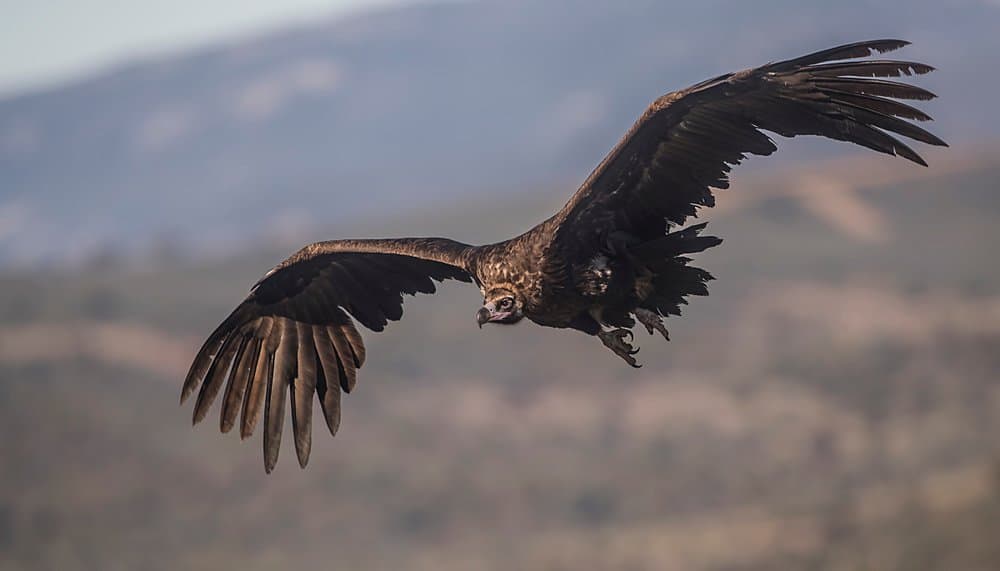
The broad, blunt wings which keep this leviathan aloft give the Eurasian black vulture its striking profile.
©Pascal De Munck/Shutterstock.com
Andean Condor
| Andean Condor | Size |
|---|---|
| Maximum Weight: | 33 pounds |
| Maximum Wingspan: | 10.5 feet |
The Andean condor is the largest of all flying birds and the biggest bird of prey in the world. The Andean condor, a member of the vulture family, has the traditional bald head.
This helps it keep its neck and face clean while consuming carrion. Although this bird’s enormous wingspan could give the impression that it flies gracefully, it actually occasionally struggles to stay in the air due to its weight.
In order to support itself in midair, the Andean condor tends to stay on flight courses that take advantage of mountain air currents. This enormous condor lacks the formidable talons of some of the other birds of prey. It has been observed supplementing its diet with other birds’ eggs or chicks.
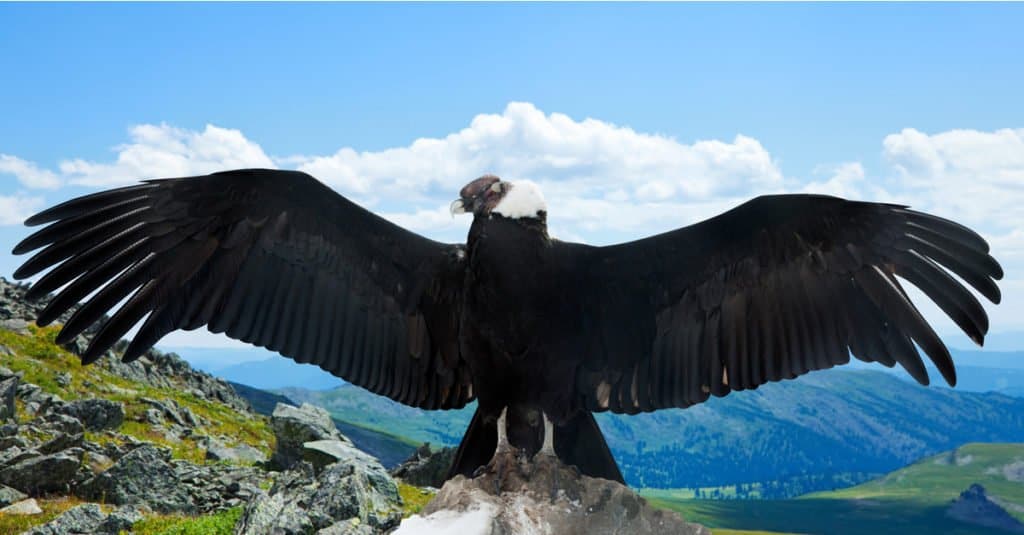
The Andean condor is the largest of all flying birds and the biggest bird of prey in the world.
©BearFotos/Shutterstock.com
Summary Of 5 Huge Predators Larger Than Today’s Bald Eagles
| Rank | Animal | Weight | Wingspan |
|---|---|---|---|
| 5 | Steller’s Sea-Eagle | 20 pounds | 8 feet |
| 4 | California Condor | 24 pounds | 9.8 feet |
| 3 | Himalayan Griffon Vulture | 28 pounds | 9.2 feet |
| 2 | Eurasian Black Vulture | 21 pounds | 10.2 feet |
| 1 | Andean Condor | 33 pounds | 10.5 feet |
The photo featured at the top of this post is © iStock.com/emranashraf
Sources
- Safaris Africana, Available here: https://safarisafricana.com/largest-eagles-in-the-world/
- Largest.org, Available here: https://largest.org/animals/eagles/
- MDC, Available here: https://mdc.mo.gov/discover-nature/field-guide/bald-eagle
Thank you for reading! Have some feedback for us? Contact the AZ Animals editorial team.






